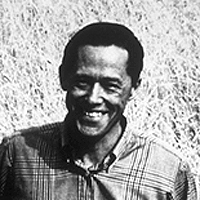Success Starts Here
Your gateway to the Library Catalog, Digital Items, Library Website search results, and more simultaneously!
Your gateway to the Library Catalog, Digital Items, Library Website search results, and more simultaneously!


Dale Thompson Fletcher was born on February 21, 1929 in Utah. Fletcher was a painter and a teacher of studio, art history, and elementary education courses. He died May 21, 1990.
Fletcher earned a bachelor of science from Utah State University in 1953, and a Masters of Arts from the University of California in Berkeley in 1956. He joined the art faculty at BYU in 1965 and taught there until he unexpectedly resigned to pursue a cult of pyramidology.
Fletcher's works were shown at a number of galleries, he even won the purchase prize at the Institute of Fine Arts exhibit of 1961. In the late 1970s Fletcher was appointed to the directorship of BYU's art gallery.
Biography adapted from Artists of Utah.
While painting an abstract oil, Black to Bury By, a dark spot on the canvas riveted his attention and finally the painting was almost entirely black except for a thin white horizon at the top with a golden menorah. He intuitively glued on a plastic sheep and wrote upon it at the margin "Aholiab" and titled the picture Artist Called of God after the old testament artisan. After this eerie experience, which frightened him, he never again painted another non-objective work as Marvin Payne explains:
"He wondered about the place of the artist in the eyes of the Lord and doubted his value to the kingdom. This doubt was reflected in his painting... He retreated to the scriptures and tried a device which might be regarded by some as haphazard, but nevertheless he tried it. He held the Bible by its right-hand edge, then stood it up on its spine and let it fall open to a random page. It fell open to the thirty-first chapter of Exodus [1-6]. He closed his eyes and let his hand fall on the first verse:
"And the Lord spake unto Moses saying, See I have called by name Bezaleel the son of Uri, the son of Hur, of the tribe of Judah: And I have filled him with the spirit of God, in wisdom and in understanding, and in knowledge, and in all manner of workmanship, To devise cunning works, to work in gold, and in silver, and in brass, and in cutting of stones, to set them and in carving of timber, to work in all manner of workmanship. And I, behold, I have given with him Aholiab... and in the hearts of all that are wise hearted I have put wisdom, that they may make all that I have commanded thee."
"This was the first [and only] instance Dale had ever encountered in the scriptures of artists being actually called by the Lord to serve Him, and he was thrilled. He returned immediately to his blackened-out canvas and painted one white strip along the top. Just under that, he wrote in white paint the word Aholiab. Since that experience, Dale Fletcher has devoted his talent to praising the Lord by recording with painstaking detail the glory of the Lord as manifest in the works of His hands that surround us in nature."
In his own words the artist about 1972, explains Mother's Garden: Irene's Strawberry Patch:
"That was the day I worked on an old ornery abstract expressionistic canvas and finally painted it all black [An Artist Called of God 1960]. I went to bed wondering if I might give up painting... In the morning I sat before my black canvas and placed my Bible on my knee and let it drop open. It opened to Exodus 31 which struck me so forcibly that I have never gotten over it. I'm still trying to comprehend it, but somehow it was a catalyst. That day I got a tiny brush and went out under that same apple tree and looked again. I began copying. It seemed absurd, like some kind of meaningless penance, like standing on one's head. After several full days of this I found that I was beginning to unravel, losing myself among the leaves. I lost my feeling of responsibility to be an artist, to compose well, etc. Instead I was only to doff my hat to the myriad entities of---nature before me; that is, look at each thing and confess its validity as is.
"Somehow my own validity seemed to be related to establishing that. By and by I began to feel a part of it all again---"earth-life paintings." There was such sheer quantity of stuff and not at all chaotic if you scrutinized it. The real stuff transcended any painting I knew, so it was not a question of returning to naturalism or realism, but of going forward, hopefully, into the area of difference which existed between nature and painting."
He had profoundly undergone a spiritual metamorphosis. During the summer of 1959, while living at River Heights, he drew with brush and ink in his mother's overgrown strawberry patch in Logan.
Biography courtesy Springville Museum of Art.
Books
Olpin, Robert S., William C. Seifrit, and Vern G. Swanson. Artists of Utah. Salt Lake City, UT: Gibbs Smith Publisher, 1999.
Swanson, Vern G., Robert S. Olpin, Donna Poulton, and Janie Rogers. Utah Art, Utah Artists: 150 Year Survey. Layton, UT: Gibbs Smith Publisher, 2001.
Swanson, Vern G., Robert S. Olpin, and William C. Seifrit. Utah Painting and Sculpture. Layton, UT: Gibbs Smith Publisher, 1991.